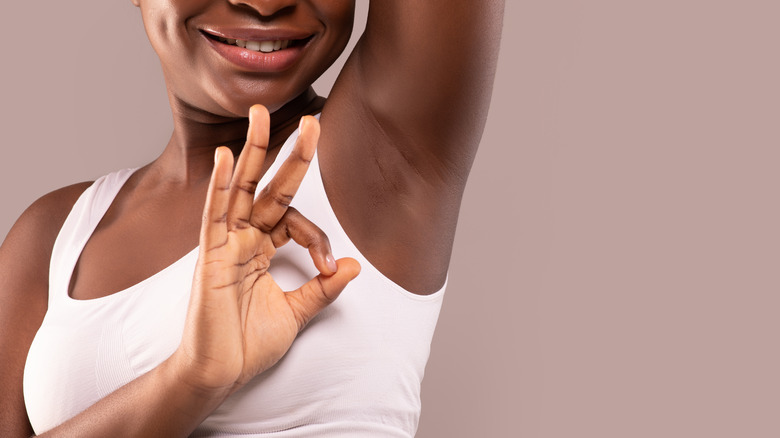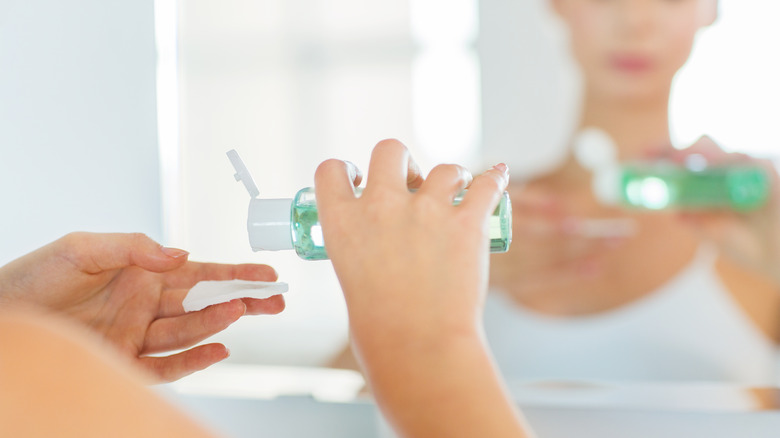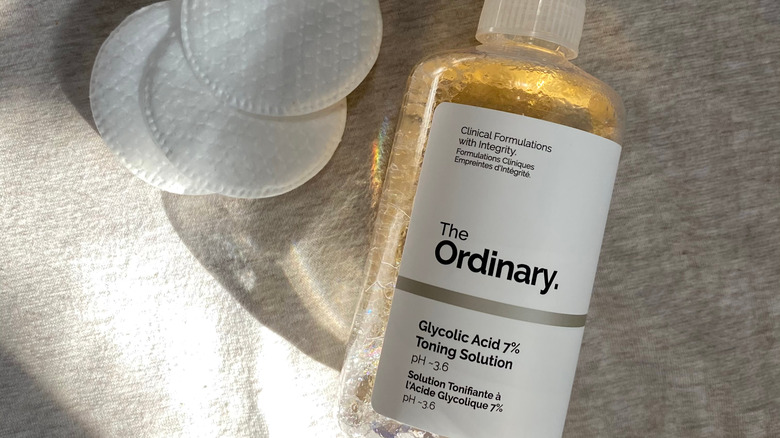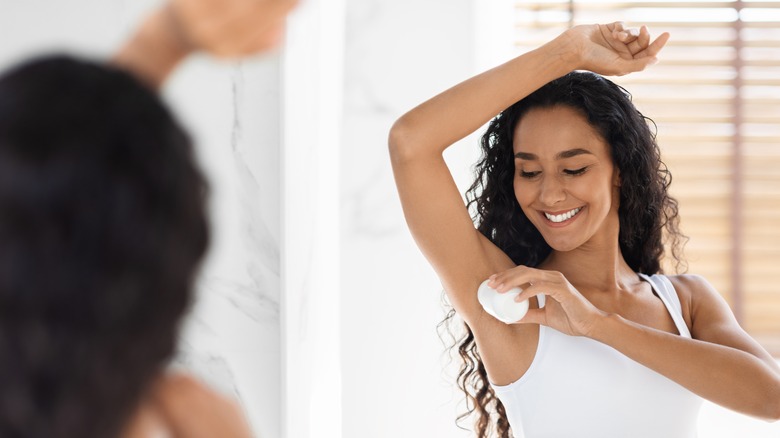Can Using Glycolic Acid On Your Underarms Replace Deodorant?
TikTok has a way of convincing people to try the oddest of beauty hacks. Sometimes, they're a huge hit, like The Ordinary's peeling solution, which leaves some people's skin incredibly red but, after some time, glowing. Other times, they go viral for the wrong reasons, like that time when using lube as a primer went viral and very quickly fell flat.
Beauty TikTok is an ever-turning wheel of beauty trends and viral products, but it takes a lot of research to weed out the good from the seriously harmful, especially when the beauty hack is as unusual as acid-toning your underarms.
TikTok user @Calistatee has built quite the following as fans love her beauty product review videos. She went viral when she tapped into a niche of glorifying The Ordinary's Glycolic Acid Toner as a multi-purpose wonder product. Calista used the toner to tackle everything from bacne to cracked heels, and the visible results spoke for themselves. But she especially threw people for a loop when she revealed that her favorite use of the toner was actually for her underarms. But does it actually work? And, more importantly, is it safe?
What is glycolic acid?
Before you jump on the glycolic acid bandwagon, you should understand how it affects the skin. The glycolic acid found in skincare products is derived from a naturally occurring compound found in sugarcane, per Healthline. This type of chemical exfoliant is categorized as an alpha hydroxy acid (AHA), which, similar to beta hydroxy acids (BHAs), encourages intense exfoliation and resurfacing. When applied to the skin, glycolic acid disposes of dead cells to improve skin texture by unclogging pores and smoothing surface-level wrinkles (via Paula's Choice). Unlike a BHA, however, AHA does not penetrate deep into the skin layer, which makes it less irritating for people with dry or sensitive skin types.
This seemingly all-purpose exfoliating acid also happens to reduce hyperpigmentation caused by acne, sun damage, or hormonal imbalances, which further supports its popularity among skincare enthusiasts. While glycolic acid traditionally works well to target fine lines, hyperpigmentation, and the occasional breakout, it may not provide a deep exfoliation to help those with oily or acne-prone skin, according to Healthline.
What are the claims about glycolic acid toners?
In a TikTok video, @Calistatee explained why she loves using glycolic acid toner on her underarms. Calista claimed that applying glycolic acid to your underarms removes odor, helps with ingrown hairs, and brightens skin. In fact, she claims the toner has replaced deodorant for her.
Glycolic acid is a skincare favorite. When used correctly, glycolic acid can chemically exfoliate your skin to reveal glowy, softer skin. "It essentially works by breaking the bonds between dead skin cells which helps to resurface (or smooth) the top layer of the skin," Dr. Ana explained to Refinery29. But what about how people claim it works on underarms?
Calista, along with many other TikTok fans of the method, has turned to using glycolic acid on their underarms to brighten the area, as well as — and perhaps most importantly — to replace deodorant. Considering people have tried everything including Botox in their underarms to keep sweat in check, this seems like a much more affordable way to achieve this goal. But what do the experts have to say about it?
The experts weigh in on underarm use of this toner
Perhaps we should start with the good news. Dermatologist Dr. Fatima Fahs explained to Nylon that glycolic acid could, in fact, help brighten your underarms, saying, "Toners that contain ingredients like glycolic acid can indeed be helpful at brightening this area through exfoliation by sloughing off the top layer of skin cells over time." Meanwhile, Dr. Rachel Maiman revealed to Bustle that it can also work well at preventing ingrown hairs. "It can also reduce the propensity to develop ingrown hairs and speed resolution of hyperpigmentation that they tend to leave behind," she explained. Well, unfortunately, that's where the pros stop.
Experts seem to agree that there's no way glycolic acid can entirely replace your deodorant. On this, Dr. Ana bluntly insisted to Refinery29, "I am not a fan of this trend at all and would definitely recommend sticking to tried and tested deodorants (masking odor) or antiperspirants (reducing sweat) formulations with research behind their use. Skincare should be backed by science, not trends."
So, why do people insist that glycolic acid can replace deodorant? Glycolic acid doesn't reduce sweat or body odor. It does, however, balance your skin's pH levels while unclogging sweat glands and follicles, which makes it difficult for odor-causing bacteria to thrive, thereby reducing the intensity of your body odor. If you want to mask odor or reduce sweat production, then opt for a deodorant or antiperspirant containing aluminum.
Risks of using glycolic acid on your armpits
The problem isn't only the lack of impact it has on body odor, but it turns out that using glycolic acid on your underarms could potentially be harmful. Dr. Marisa Garshick revealed to Today that using glycolic acid on your underarms could lead to dryness, flakiness, and irritation. That being said, if you're still willing to try it, then make sure you stick to low concentrations of 8% to 10% glycolic acid to prevent any harsh reactions.
Many people use glycolic acid to decrease the appearance of dark spots and hyperpigmentation in the skin, but it can also worsen dark spots for some individuals. For instance, those with darker skin should take care when using glycolic acid, as irritation caused by the skincare ingredient can sometimes lead to post-inflammatory hyperpigmentation and further darkening of the underarms, per Healthline.
For this reason, you should not apply glycolic acid to irritated or compromised skin to reduce the chance of irritation and hyperpigmentation, as is the case with most exfoliating products. Those with sensitive skin should use glycolic acid sparingly, as high concentrations of this AHA can increase sensitivity, especially when used on the delicate skin of the underarms. That said, glycolic acid provides valuable benefits to the skin if you conduct a patch test first and stick to a maximum of 8% to 10% glycolic acid to prevent irritation or a severe reaction.




